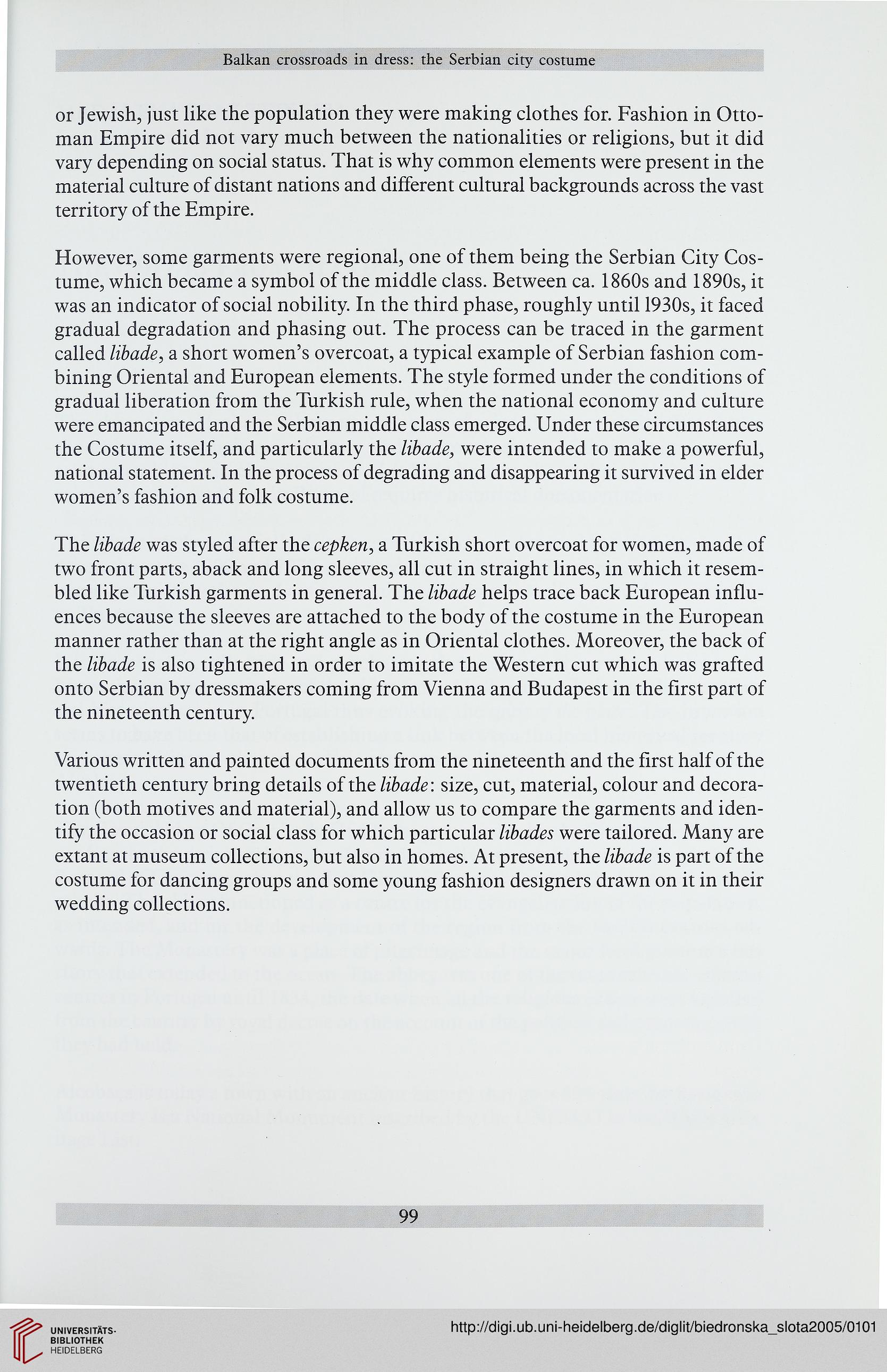Bałkan crossroads in dress: the Serbian city costume
or Jewish, just like the population they were making clothes for. Fashion in Otto-
man Empire did not vary much between the nationalities or religions, but it did
vary depending on social status. That is why common elements were present in the
materiał culture of distant nations and different cultural backgrounds across the vast
territory of the Empire.
However, some garments were regional, one of them being the Serbian City Cos-
tume, which became a symbol of the middle class. Between ca. 1860s and 1890s, it
was an indicator of social nobility. In the third phase, roughly until 1930s, it faced
gradual degradation and phasing out. The process can be traced in the garment
called libade, a short women's overcoat, a typical example of Serbian fashion com-
bining Oriental and European elements. The style formed under the conditions of
gradual liberation from the Turkish rule, when the national economy and culture
were emancipated and the Serbian middle class emerged. Under these circumstances
the Costume itself, and particularly the libade, were intended to make a powerful,
national statement. In the process of degrading and disappearing it survived in elder
women's fashion and folk costume.
The libade was styled after the cepken, a Turkish short overcoat for women, made of
two front parts, aback and long sleeves, all cut in straight lines, in which it resem-
bled like Turkish garments in generał. The libade helps tracę back European influ-
ences because the sleeves are attached to the body of the costume in the European
manner rather than at the right angle as in Oriental clothes. Moreover, the back of
the libade is also tightened in order to imitate the Western cut which was grafted
onto Serbian by dressmakers coming from Vienna and Budapest in the first part of
the nineteenth century.
Various written and painted documents from the nineteenth and the first half of the
twentieth century bring details of the libade: size, cut, materiał, colour and decora-
tion (both motives and materiał), and allow us to compare the garments and iden-
tify the occasion or social class for which particular libades were tailored. Many are
extant at museum collections, but also in homes. At present, the libade is part of the
costume for dancing groups and some young fashion designers drawn on it in their
wedding collections.
or Jewish, just like the population they were making clothes for. Fashion in Otto-
man Empire did not vary much between the nationalities or religions, but it did
vary depending on social status. That is why common elements were present in the
materiał culture of distant nations and different cultural backgrounds across the vast
territory of the Empire.
However, some garments were regional, one of them being the Serbian City Cos-
tume, which became a symbol of the middle class. Between ca. 1860s and 1890s, it
was an indicator of social nobility. In the third phase, roughly until 1930s, it faced
gradual degradation and phasing out. The process can be traced in the garment
called libade, a short women's overcoat, a typical example of Serbian fashion com-
bining Oriental and European elements. The style formed under the conditions of
gradual liberation from the Turkish rule, when the national economy and culture
were emancipated and the Serbian middle class emerged. Under these circumstances
the Costume itself, and particularly the libade, were intended to make a powerful,
national statement. In the process of degrading and disappearing it survived in elder
women's fashion and folk costume.
The libade was styled after the cepken, a Turkish short overcoat for women, made of
two front parts, aback and long sleeves, all cut in straight lines, in which it resem-
bled like Turkish garments in generał. The libade helps tracę back European influ-
ences because the sleeves are attached to the body of the costume in the European
manner rather than at the right angle as in Oriental clothes. Moreover, the back of
the libade is also tightened in order to imitate the Western cut which was grafted
onto Serbian by dressmakers coming from Vienna and Budapest in the first part of
the nineteenth century.
Various written and painted documents from the nineteenth and the first half of the
twentieth century bring details of the libade: size, cut, materiał, colour and decora-
tion (both motives and materiał), and allow us to compare the garments and iden-
tify the occasion or social class for which particular libades were tailored. Many are
extant at museum collections, but also in homes. At present, the libade is part of the
costume for dancing groups and some young fashion designers drawn on it in their
wedding collections.




